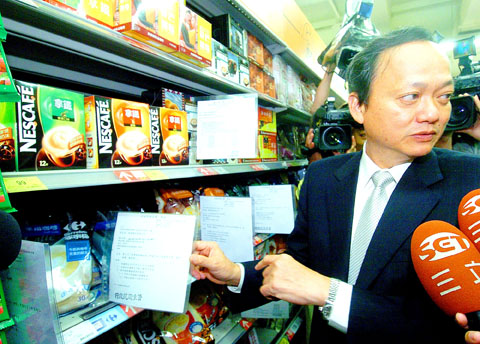By Shelley Huang Staff Reporter, with CNA
Department of Health Minister Yeh Ching-chuan (葉金川) told reporters yesterday that “no melamine detected” does not mean a product contains zero parts per million (ppm) of melamine, but rather that no melamine could be detected with the testing method used and that the product is “fit for consumption.”
In response to the recent controversy over whether the government had eased its standards on the permissible concentration of melamine from zero ppm to 2.5ppm, Yeh said a Cabinet-level inter-agency panel would discuss the definition of “standard” levels of melamine on Tuesday and seek to standardize testing procedures nationwide despite the fact that different testing instruments are available in different regions.

PHOTO: LU CHUN-WEI, TAIPEI TIMES
CERTIFIED LABS
The Department of Health (DOH) said the nation’s five laboratories certified for testing, including the Food Industry Research and Development Institute, had been working night and day to cope with the growing backlog of companies that need to have products tested.
The DOH said it planned to have another 16 labs certified by the Taiwan Accreditation Foundation to help with melamine testing.
The labs, when ready, will accept samples seven days a week, it said.
Yeh said yesterday that the DOH would meet local health authorities in 25 counties and cities tomorrow to coordinate inspection procedures.
On Tuesday, the DOH will contact experts in the US, Japan, Australia, New Zealand and the EU to collaborate on standard inspection procedures and setting a threshold for melamine detection, he said.
‘STRICTEST STANDARDS’
Yeh said the government was responsible for screening all imported foodstuffs and that all agencies, including the Bureau of Standards, Metrology and Inspection, the Bureau of Animal and Plant Health Inspection and Quarantine and the Bureau of Food and Drug Analysis would “apply the strictest screening standards.”
In response to a report in the Chinese-language Liberty Times (the Taipei Times’ sister newspaper) that customs personnel had not yet received lists of banned imports, Yeh said the task force had confirmed that instructions on banned products — including Chinese-made milk powder, other dairy products and vegetable-based proteins — had been issued as early as Tuesday.
Not one banned product has made it past Taiwan’s borders since, he said.
RANDOM CHECKS
Meanwhile the DOH said yesterday that it would step up its random examination of food products from countries with dubious food safety standards.
“We have targeted products from certain countries with questionable standards and we do not rule out the possibility of carrying out the strictest batch-by-batch examinations of suspect products,” Yeh said, declining to name any countries.
Asked to comment on the scandal involving Pizza Hut, Yeh said it was only one case and that the source of the tainted ingredients had yet to be identified.
Pizza Hut on Friday reported to the DOH that 65,000 packets of cheese powder contaminated with up to 76.2ppm of melamine may have been consumed by its customers.
Pizza Hut has since recalled all unused cheese packets.
To date, five cases of kidney stones have been reported nationwide that could be linked to melamine.

Beijing could eventually see a full amphibious invasion of Taiwan as the only "prudent" way to bring about unification, the US Department of Defense said in a newly released annual report to Congress. The Pentagon's "Annual Report to Congress: Military and Security Developments Involving the People's Republic of China 2025," was in many ways similar to last year’s report but reorganized the analysis of the options China has to take over Taiwan. Generally, according to the report, Chinese leaders view the People's Liberation Army's (PLA) capabilities for a Taiwan campaign as improving, but they remain uncertain about its readiness to successfully seize

Taiwan is getting a day off on Christmas for the first time in 25 years. The change comes after opposition parties passed a law earlier this year to add or restore five public holidays, including Constitution Day, which falls on today, Dec. 25. The day marks the 1947 adoption of the constitution of the Republic of China, as the government in Taipei is formally known. Back then the Chinese Nationalist Party (KMT) governed China from Nanjing. When the KMT, now an opposition party in Taiwan, passed the legislation on holidays, it said that they would help “commemorate the history of national development.” That

Taiwan has overtaken South Korea this year in per capita income for the first time in 23 years, IMF data showed. Per capita income is a nation’s GDP divided by the total population, used to compare average wealth levels across countries. Taiwan also beat Japan this year on per capita income, after surpassing it for the first time last year, US magazine Newsweek reported yesterday. Across Asia, Taiwan ranked fourth for per capita income at US$37,827 this year due to sustained economic growth, the report said. In the top three spots were Singapore, Macau and Hong Kong, it said. South

Snow fell on Yushan (Jade Mountain, 玉山) yesterday morning as a continental cold air mass sent temperatures below freezing on Taiwan’s tallest peak, the Central Weather Administration (CWA) said. Snowflakes were seen on Yushan’s north peak from 6:28am to 6:38am, but they did not fully cover the ground and no accumulation was recorded, the CWA said. As of 7:42am, the lowest temperature recorded across Taiwan was minus-5.5°C at Yushan’s Fengkou observatory and minus-4.7°C at the Yushan observatory, CWA data showed. On Hehuanshan (合歡山) in Nantou County, a low of 1.3°C was recorded at 6:39pm, when ice pellets fell at Songsyue Lodge (松雪樓), a